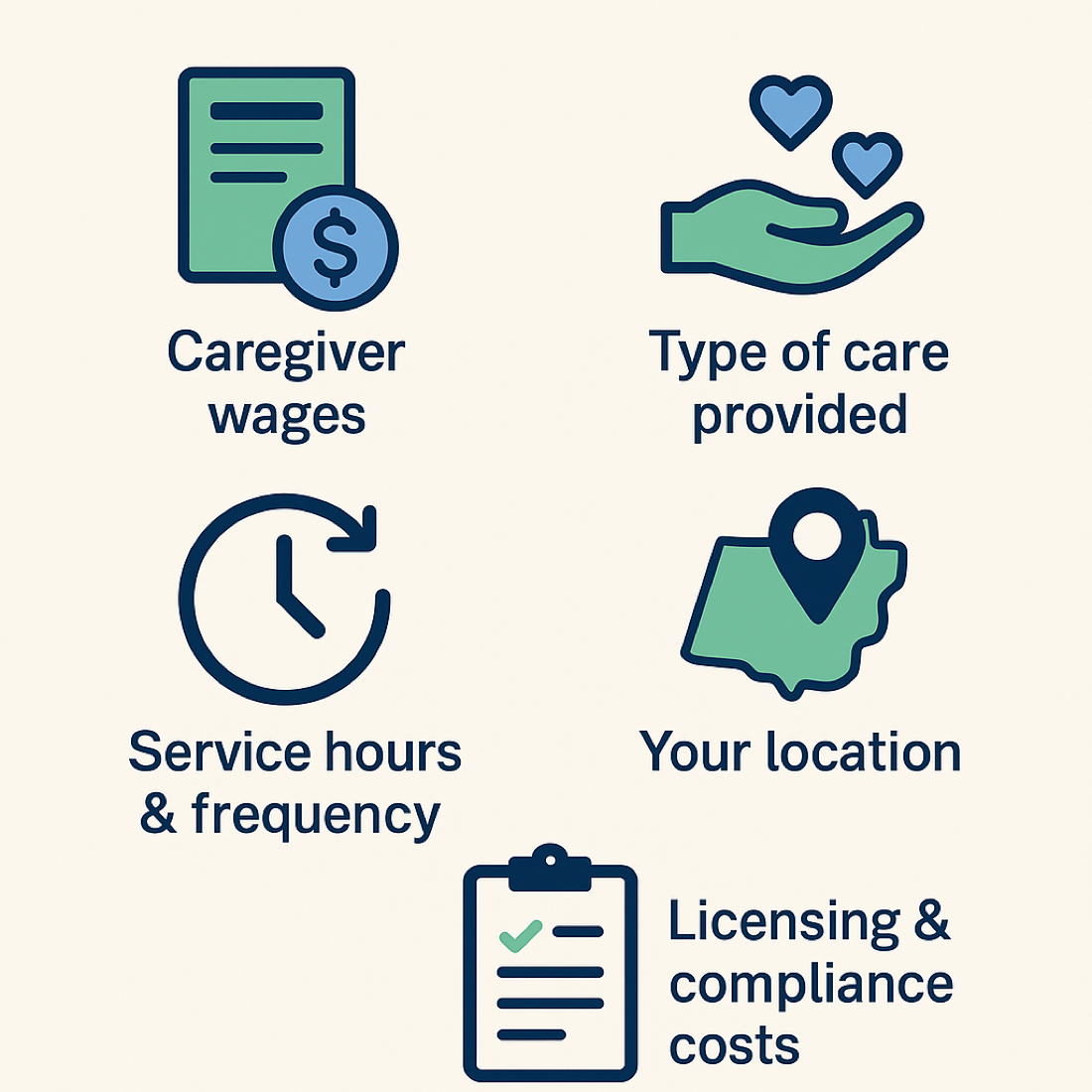How Much Should Your Home Care Agency Be Charging Clients in Texas?
If you’re running a home care agency in Texas, one of the biggest decisions you’ll make is pricing. Charge too much, and families turn to your competitors. Charge too little, and you’re running a business that barely pays the bills.
Texas is one of the biggest home care markets in the U.S. Competition is fierce, and costs are rising. So, if you want to grow, you need a smart, strategic pricing model—one that makes sense for families, keeps your agency profitable, and allows you to attract and keep great caregivers.
However, most agency owners don’t know where to start. That is why today, we will break it all down.
What should your agency be charging? What’s the real cost of home care in Texas? And how do you price your services in a way that actually works (for your agency, your clients, and your caregivers)?
What Are Other Agencies Charging for Home Care in Texas?
Home care pricing isn’t one-size-fits-all. It depends on the city, the level of care, and what your agency offers.
The Current Numbers (Texas vs. National Rates)
According to Genworth’s 2024 Cost of Care Survey, here’s what home care looks like across Texas:
-
Hourly Rate: $24–$30 per hour
-
Monthly Cost (Full-Time Care, 44 hrs/week): $4,600–$5,200
-
Live-In Care: $7,000+ per month
Now, compare that to the national average:
-
Hourly Rate: $30–$34 per hour
-
Monthly Cost: $5,720 per month
Texas is cheaper than most states, but costs are rising. If you’re not adjusting your pricing accordingly, you’re leaving money on the table.
City-by-City Breakdown
-
Austin: $5,200/month
-
Houston: $4,800/month
-
Dallas: $4,900/month
-
San Antonio: $4,500/month
-
Amarillo: $4,075/month
Your rates should reflect where you’re operating. An agency in Austin or Dallas will naturally charge more than one in Texas.
The 5 Things That Should Determine Your Pricing

Most agencies set their rates based on competition, and that’s a mistake.
If your home care agency is going to thrive in Texas, your prices need to reflect the true cost of running your business while staying competitive.
Here’s what actually affects what you should charge:
1. Caregiver Wages (Your Biggest Expense)
Caregivers are the backbone of your agency. Pay them well, and they’ll stay. Pay them too little, and you’ll be stuck in a constant cycle of hiring and turnover.
Texas caregivers earn around $13–$18 per hour depending on experience, but to get (and keep) the best, you need to offer above-market pay. If you’re not accounting for fair wages in your pricing, you’ll lose talent.
2. Type of Care Provided
Not all home care provides the same level of care. Rates should adjust based on care complexity:
-
Companionship & Homemaking: $24–$26 per hour
-
Personal Care (Bathing, Dressing, Mobility Assistance): $26–$28 per hour
-
Specialized Care (Alzheimer’s, Stroke Recovery, 24/7 Supervision): $28–$30 per hour
3. Service Hours & Frequency
Some care agencies' prices are the same no matter the time of day. Big mistake.
-
Weekends and nights? Charge more.
-
Short shifts (under 3 hours)? Charge more. Most agencies set a 4-hour minimum per shift to ensure profitability.
-
Live-in or 24/7 care? Package it into a flat daily or weekly rate.
4. Your Location
Urban areas like Dallas and Houston charge higher rates because the cost of living (and caregiver pay) is higher. It’s that simple.
If you’re in a city with a booming economy, you can charge at the higher end of the range. If you’re in a smaller town, you might need to adjust down but not so much that you undervalue your services.
5. Licensing & Compliance Costs
Texas requires agencies to be licensed through Texas Health and Human Services (HHS), which costs $1,750 every two years. Add in insurance, marketing, caregiver training, and background checks, and you’re looking at thousands in expenses every year.
If your pricing doesn’t cover your costs, your business won’t last.
Home Care Pricing Models: What Works Best?
Most agencies charge hourly, but some use daily, live-in, or package pricing. Which model works best for your agency?
1. Hourly Rates (Most Common)
Hourly pricing gives families flexibility but requires a minimum number of hours per visit to be profitable.
-
Average in Texas: $24–$30 per hour.
-
Best for: Clients that need occasional care.
Tip: Avoid “one-hour” shifts. They’re not worth the scheduling hassle. Stick to a 4-hour minimum.
2. Flat Daily or Live-In Rates
For clients that need round-the-clock care, live-in caregivers are more affordable than paying by the hour.
-
Typical Rates in Texas: $200–$300 per day.
-
Best for: Clients that need 24/7 supervision.
Tip: Clearly define what’s included. Some agencies add extra charges for nights and weekends.
3. Package Pricing (Bundled Services)
Offering set packages helps clients budget better and increases retention.
-
Day Care Package (4 hours per day): $500–$600
-
Weekend Respite Care (12 hours over 2 days): $300–$400
Tip: Packages help reduce cancellations because once a client commits to a package, they’re less likely to cut back on hours.
How to Set Your Prices (Without Losing Clients)

If you set your rates too low, you’ll struggle to pay caregivers.
If you set your rates too high, you’ll drive away potential clients.
Here’s how to find the right balance:
1. Check Local Competitor Rates (But Don’t Copy Them)
You need to know what competitors are charging, but more importantly, what they’re offering at those prices.
-
Are they charging less because they cut corners on caregiver wages?
-
Are they charging more because they specialize in a specific type of care?
Check their websites, talk to families, and find out what real agencies in your area are doing.
2. Factor in ALL Your Costs
Calculate your total expenses: caregiver wages, payroll taxes, insurance, marketing, licensing fees, and overhead. Your rates should cover everything and leave room for profit.
3. Offer Premium Services (and Charge for Them)
If your agency provides highly trained caregivers, concierge services, or specialized programs (like dementia care or fall prevention assessments), you should be charging more.
Your pricing should reflect the unique value you bring to the market.
4. Adjust Your Prices Annually
Costs rise every year—so should your rates. The best agencies review their pricing annually to stay profitable.
Texas-Specific Pricing Considerations
1. Texas Medicaid & Reimbursement Rates
If you’re serving Medicaid clients (STAR+PLUS program), you’ll need to work within the state’s reimbursement limits. Texas Medicaid pays $15–$18 per hour, far below private pay rates.
Some agencies choose to avoid Medicaid altogether and focus on private-pay clients instead. Others mix both, using private-pay clients to offset Medicaid’s lower reimbursements.
2. State Licensing Requirements
Texas requires home care agencies to be licensed through Texas HHS. While there are no price regulations, all agencies must comply with licensing, insurance, and caregiver training standards.
3. Market Demand & Competition
Texas has a growing senior population and a high demand for home care. That’s good news, but competition is fierce. If your agency doesn’t differentiate itself, you’ll struggle to attract clients.
Final Thoughts: Get Your Pricing Right & Stay Profitable
Pricing isn’t just a number, it’s a message. It tells families what to expect. It tells caregivers how much you value their work. And it tells the market whether you’re running a business built to last or one that’s barely getting by.
If you’re in Texas, you have a unique opportunity. The demand for care is growing, and costs are still competitive compared to other states. But that window won’t stay open forever. The agencies that thrive are the ones that know their worth, understand their market, and set rates that reflect both.
There’s no perfect formula. But there is a smart way to do this with clear strategy, careful research, and the confidence to charge what your care is truly worth. The families who choose you, and the caregivers who work with you, deserve that level of thoughtfulness.
Don’t guess. Don’t copy what everyone else is doing. Lead with clarity. Lead with value. And let your pricing reflect the strength of the agency you’ve built.
Because in this business, how you charge speaks volume about how you serve.